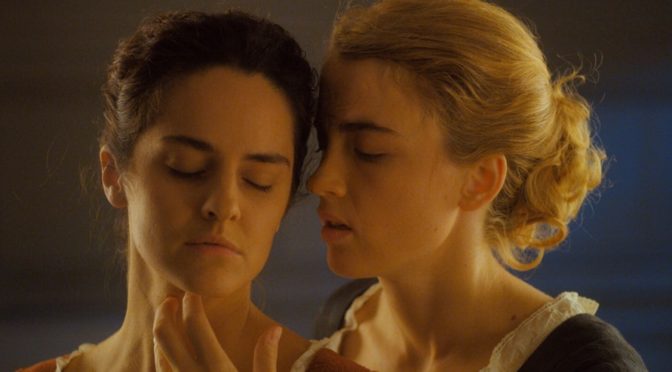 Céline Sciamma’s period drama PORTRAIT OF A LADY ON FIRE, set in eighteenth-century Brittany, begins as a lesson in portraiture. As we see the tentative first strokes of graphite on canvas, we hear the calm voice of protagonist Marianne (Noémie Merlant) instructing her young female pupils to closely observe the details of what they are sketching. Eventually, it is Marianne herself who is revealed to be the subject of the girls’ investigative looks, playing the role of both tutor and live model.
Céline Sciamma’s period drama PORTRAIT OF A LADY ON FIRE, set in eighteenth-century Brittany, begins as a lesson in portraiture. As we see the tentative first strokes of graphite on canvas, we hear the calm voice of protagonist Marianne (Noémie Merlant) instructing her young female pupils to closely observe the details of what they are sketching. Eventually, it is Marianne herself who is revealed to be the subject of the girls’ investigative looks, playing the role of both tutor and live model.
This opening prelude signals the film’s investment in exploring what Sciamma refers to as the ‘creative relationship between viewer and viewed,’ thereby interrogating the status of women as both objects and potential subjects of vision, and challenging the traditional power relationships implicit in that dynamic.
“Sciamma draws here on a rich set of literary and visual intertexts — from Orpheus and Euridice to Hitchcock’s VERTIGO — that are re-framed in light of the film’s queer and feminine aesthetic.”
The central storyline of PORTRAIT OF A LADY ON FIRE pivots around the question of whether Marianne will succeed in painting the portrait of a young woman, Héloïse (Adèle Haenel) whose maidservant describes her as being ‘unpaintable’. Requiring her daughter’s likeness in order to secure her marriage to a Milanese businessman, Héloïse’s mother concocts a strategem whereby Marianne will pose as a daytime companion while secretly painting Héloïse from memory in the evening. Marianne is presented here as a technically proficient, self-assured agent who is conscripted to seal Héloïse’s fate. But if the film initially presents Marianne as the more powerful of the two, Sciamma’s film will go on to artfully reverse that dynamic, as Héloïse trains her own powers of observation onto Marianne, revealing her to be much more vulnerable than she at first appears. As the relationship between the pair intensifies, the dynamic between observer and observed is displaced, opening onto a mutual—if by necessity transient—love affair.
Sciamma draws here on a rich set of literary and visual intertexts — from Orpheus and Euridice to Hitchcock’s VERTIGO — that are re-framed in light of the film’s queer, lesbian and feminine aesthetic. Sciamma treats these references with a deftness of touch that allow them to reverberate across the film’s narrative, rather than tethering them down to fixed or obvious interpretations. Likewise, Sciamma’s austere, precise visual aesthetic works to counterbalance the film’s moments of unbridled emotional depth, as well as to place it within a recognisable historical frame. Crucially, the film also draws on a wider community of women who are called on at a particularly powerful and eerie moment to instruct and abet the lovers through their practices that are marked as both feminine and occult. In sum, PORTRAIT is a gripping love story, as well as a subtle and powerful reclamation of history’s ‘unpaintable’ subjects.


Can I simply just say what a comfort to discover somebody that truly knows what they are talking
about on the net.